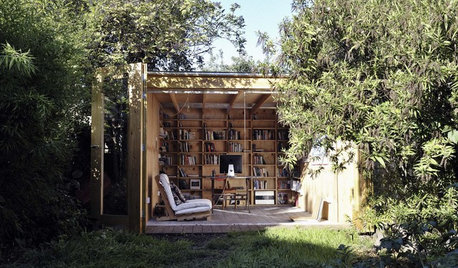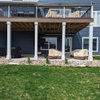I need to re grade the backyard.Do I remove the sod or I turn it over?
Ivan Turbinca
8 years ago
last modified: 8 years ago
Featured Answer
Sort by:Oldest
Comments (14)
Yardvaark
8 years agoRelated Discussions
Over zealous Grading - I Should have known better
Comments (15)Some of your photos are a little too close-up which makes it hard to grasp the context. What's certain is that the excavation needs to be somewhat larger than the finished product and then backfilled. I wouldn't label this overzealous grading. It requires a little extra room to perform the construction. So you see the maximum extent of space you have to build a patio. But there's nothing to stop you from shrinking it if you desire. However, thinking that putting dirt back around a tree is somehow equivalent to putting roots back is just not accurate. An amputation cannot be undone. Putting dirt back will make no difference. In spite of that, the tree will re-grow some roots as that's what they do. The ultimate patio size is a factor of desire and space available, but as patios go, it certainly doesn't look too large. Neither does it look like the ret. wall will be abnormally tall. Its curved shape will add strength. It will be stepping or sloped down in some way to generally follow the earth so it's highest section will not extend for great width. Its height is a balancing act between the patio elevation and the surrounding soil levels. Calculate these out and adjust them as you see fit. Raise the patio too much and you will be filling the bottom end or shrinking the patio size. Lower it and you'll be creating a taller retaining wall. Balance and moderation are the key. As I look at the pictures, I don't see anything that can't be worked out to a decent conclusion... if the right design decisions are made along the way. If this were my yard, I'd prefer the appearance of a nicely detailed mortared stone wall, but that requires more skill and higher cost material than the kind of block you're proposing. Therefore, it would be more expensive. But it would look better, too. What you decide on is a factor of cost vs. benefits as you see it. At the end of it all, it will be imperative that you establish groundcover capable of holding soil in place. This is a key to preventing erosion....See MoreRe-grade and re-sod lawn
Comments (1)This might be an inexpensive fix. Can you post a picture or two showing what you're starting with? The best pictures are taken on a cloudy day without direct sunlight. It is getting to be crunch time for renovating a lawn, so the sooner the better. Caring for a lawn is as simple as watering, mowing, and fertilizing, but you have to be doing those thing right. Doing them wrong leads to weeds and disease, so please ask before you do anything or commit to anything. Pictures first....See MoreHelp Bill Vincent et al. Should I Remove Tile and Start Over?
Comments (9)Hello Karen, Sorry it took me so long to find this thread. Bill left a trail of breadcrumbs though and that's helped me along. :) So, from what I see in the photos it's a textbook Bay Area "single-coat mortar installation". He's got a moisture barrier of Aqua-Bar asphalt-impregnated Kraft paper and he's used 1" galvanized chicken-wire for lathe. His float looks to be a nominal 5/8" thick at the exposed edges and he's been pretty dang clean judging from the surrounding walls, so I don't think he's a hack. Now for the not-so-nice news. I can also tell from the photos that he's got quite a bit of lippage on those walls. It may be that those large porcelain tiles are not "rectified" (re-milled at the factory for flatness and squareness)and so he's made the best out of warped materials? Ann Sacks, and many other boutique showrooms, sell beautiful tile but it isn't always a guarantee that it's also flat or square. The best test will be to lay a straightedge across the tile (front and back each)from corner to corner and from side to side. Can you see daylight between the straightedge and the tile? Does the straightedge teeter and rock? If either of these is the case, then your installer did his job. If the tiles are flat however, he's ruined some very fine material. Without a better picture of the return-walls, I can't tell you why he chose the cuts he did. It may be that he allowed the niche's dimensions to dictate his layout, rather than the other way-round? All-in-all, it's not a terrible job and grouting may shine it right up or it may make things worse? A good grout job is like **magic** though so I think in this case I'd share your concerns with the installer and emphasize how much you HOPE he can make things better with a spectacular grout job. He should take the hint and screw his wizards cap on tight for the task. Best of luck, Shaughnn...See MoreCan I tile over/remove an old phone jack?
Comments (10)I would never "pull out" the unused phone wires. They may well serve a useful function down the road. As an example. When I got rid of Fios and replaced it with VOIP I also wanted to use a Costco purchased Panasonic Cordless phone - a base station and six satellite phones. My VOIPP box is plugged into my router and connected to those old copper wires - the ones I did not "pull out." Elsewhere in my home I located the cordless base set and connected that base set to the same wires I did not "pull out." I have two other telephones that I leave connected to those wires I did not "pull out" - one in my basement shop and one near my desk. If I lose all electric power, as long as my router is connected to its UPS I am able to use either of those two phones for incoming or outgoing calls. In other words, if those old copper wires are not being used why would you pull them out? Just leave them where they are....See Moret_d_harvey
8 years agoIvan Turbinca
8 years agot_d_harvey
8 years agoYardvaark
8 years agoIvan Turbinca
8 years agoIvan Turbinca
8 years agot_d_harvey
8 years agoIvan Turbinca
8 years agot_d_harvey
8 years agoYardvaark
8 years agoDaniel Steele
2 years agogardengal48 (PNW Z8/9)
2 years ago
Related Stories

GARDENING GUIDESHow to Plant a New Lawn From Sod
Take the quick-start route to turf with sod; these installation guidelines will help ensure a healthy and long-lasting lawn
Full Story
LIFETurn Off the Video Games and Turn On Your Kid's Creativity
Going nuts planning summer activities? Kids overdosing on screen time? It may be time to foster more self-directed play
Full Story
FUN HOUZZEverything I Need to Know About Decorating I Learned from Downton Abbey
Mind your manors with these 10 decorating tips from the PBS series, returning on January 5
Full Story
WINTER GARDENING6 Reasons I’m Not Looking Forward to Spring
Not kicking up your heels anticipating rushes of spring color and garden catalogs? You’re not alone
Full Story
TROPICAL STYLEEasy Decorating: Turn Over a New, Tropical Leaf
Toss a palm frond in a vase or gather a whole bouquet — fresh or preserved tropical leaves bring on the exotic with almost no effort
Full Story
KITCHEN DESIGNSingle-Wall Galley Kitchens Catch the 'I'
I-shape kitchen layouts take a streamlined, flexible approach and can be easy on the wallet too
Full Story
PAINTINGHelp! I Spilled Paint on My Clothes — Now What?
If you’ve spattered paint on your favorite jeans, here’s what to do next
Full Story
EXTERIORSHelp! What Color Should I Paint My House Exterior?
Real homeowners get real help in choosing paint palettes. Bonus: 3 tips for everyone on picking exterior colors
Full Story
MORE ROOMSHouzz Tour: Shed-Turned-Office in a London Garden
Working and being outdoors aren't mutually exclusive for a U.K. couple — they built an office space amid the greenery of their backyard
Full Story






PKponder TX Z7B